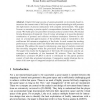Free Online Productivity Tools
i2Speak
i2Symbol
i2OCR
iTex2Img
iWeb2Print
iWeb2Shot
i2Type
iPdf2Split
iPdf2Merge
i2Bopomofo
i2Arabic
i2Style
i2Image
i2PDF
iLatex2Rtf
Sci2ools
138
click to vote
MIG
2009
Springer
2009
Springer
Integrated Analytic and Linearized Inverse Kinematics for Precise Full Body Interactions
Abstract. Despite the large success of games grounded on movement-based interactions the current state of full body motion capture technologies still prevents the exploitation of precise interactions with complex environments. This paper focuses on ensuring a precise spatial correspondence between the user and the avatar. We build upon our past effort in human postural control with a Prioritized Inverse Kinematics framework. One of its key advantage is to ease the dynamic combination of postural and collision avoidance constraints. However its reliance on a linearized approximation of the problem makes it vulnerable to the well-known full extension singularity of the limbs. In such context the tracking performance is reduced and/or less believable intermediate postural solutions are produced. We address this issue by introducing a new type of analytic constraint that smoothly integrates within the prioritized Inverse Kinematics framework. The paper first recalls the background of full ...
Computer Graphics | Inverse Kinematics Framework | Linearized Ik | MIG 2009 | Prioritized Inverse Kinematics |
| Added | 27 May 2010 |
| Updated | 27 May 2010 |
| Type | Conference |
| Year | 2009 |
| Where | MIG |
| Authors | Ronan Boulic, Daniel Raunhardt |
Comments (0)

